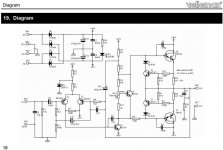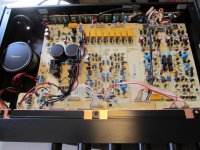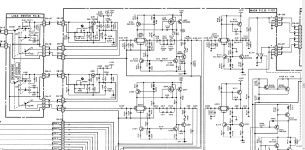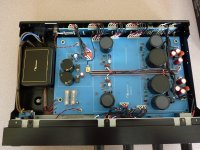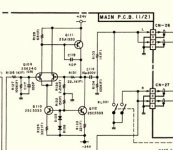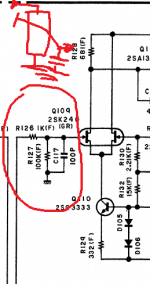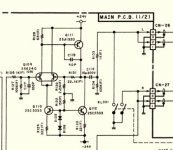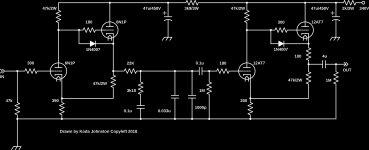If it sounds wrong but it measures right, there might be something wrong with the listener, not the circuit.
So you say 😀
My wife keeps telling me I ain’t right, I just tell her it’s the rest of the world that’s wrong......of course that results in rolled eyes. 🙄
My wife keeps telling me I ain’t right, I just tell her it’s the rest of the world that’s wrong......of course that results in rolled eyes. 🙄
LOL Sometimes it would measure wrong but sound fine to the listener... Usually in a car with awful clipping and rattling bass. I don't know how it can sound good to the person in the car when it sounds like such trash on the sidewalk 🙂
Back in my youth I took over the washtub bass in a local jug band. I’d never really done it before (after a few swigs off the mason jar everyone is a musician and everything sounds good!) but quickly noticed the tubs metal handles vibrating against the sides, I put a shop rag on each handle stifling the vibration and all of a sudden they realized how much better it sounded (you’d think les claypool just started playing with em the fuss they made!)
Anyway.......It’s amazing what some can tolerate, I think they just don’t listen.
Anyway.......It’s amazing what some can tolerate, I think they just don’t listen.
Meanwhile, I can hear glasses rattling in the kitchen on that shelf and go move the offending glass... If the amp has ANY 60/120Hz hum, there may as well be a welder in here! I can't stand it LOL
If it sounds wrong but it measures right, there might be something wrong with the listener, not the circuit
Hi ! 😀
 i tend to think the same 🙄
i tend to think the same 🙄Anyway ... i understand that darlington transistors could allow for simpler schematic. Then i see how neglected they are. Is there a love for complexity around ? i attach a very simple schematic for an amp ... tube schematics aside i think it would be very difficult to find something more minimalist
Why designers do not love darlington ? to be fair british designers used them often in very good sounding unit. I remember a cottage brand Albarry doing very nice things with TIPxxxs.
Could 513 and 515 be replaced with a darlington pair and be done with that closing there the FB loop ? just asking ... 😱
as long as good figures are obtained ...
Attachments
Last edited:
Is this a topic about the benefits of ADHD applied to electronics? Those two schematics are completely different both in outcome and composition...
Is this a topic about the benefits of ADHD applied to electronics? Those two schematics are completely different both in outcome and composition...
Why do people not love simply things ? what they have to show with overcomplex designs using tenths of active devices in a preamp line stage (i have one from Nakamichi see pic) when other people go with just one ? maybe they want to use more devices and than need other devices to correct the defects of the selected devices and on and on ...
Even more there are people who swear that that one mosfet line stage sound just better 😕
If this is true some people really need health care ... sorry
I have friend ... he is a audio sale man ... he told me that if people do not see nice enclosures, many components they are not willing to pay high prices
Is it really only a marketing issue ? i need to know
i am sure that very basic design, when rightly optimized, can provide absolutely acceptable figures and, more important, great sound
I remember a modder of Denon dvd players ... he was getting better sound taking out parts from the circuits (and in fairness replacing some key parts with better speced devices. But optimization is good of course)
Tell me that this is not only overengineering but more perverted engineering , engineering slaved to the market evil
Attachments
Last edited:
darlington transistors need on chip thermal tracking to be able to work reliably .There are very few high speed power darlingtons, most of them unavailable.
the problem is that you made the worst choice to prove your theory when showing the Rotel's circuit...I may be that the circuit itself is a complete waste within the amp's economy , i didn't study your rotel, but the circuit itself is very well put together.
I can't believe you chose the most minimalist Nelson Pass phono preamp design to prove further your theory...Man...that is the most genious phono preamp ever made.Nobody ever had better results with lower component count.Tell me that this is not only overengineering but more perverted engineering , engineering slaved to the market evil
Nakamichi CA-5A II Preamplifier Review price specs - Hi-Fi Classic
Attachments
Last edited:
darlington transistors need on chip thermal tracking to be able to work reliably. There are very few high speed power darlingtons, most of them unavailable.
Thanks ! i understand now that there are real reasons to avoid them. I just asked because years ago they were quite common in some british integrated that happened to sound also very nice. But i have very limited direct experience of these amps. Maybe they were problematic
the problem is that you made the worst choice to prove your theory when showing the Rotel's circuit...I may be that the circuit itself is a complete waste within the amp's economy , i didn't study your rotel, but the circuit itself is very well put together.
 great to know. I was just thinking to strip it down even further.
great to know. I was just thinking to strip it down even further. I encounter many line preamps with Vgain around 6 or even 10. That makes volume setting critical. Small rotation of the volume knob result in too high out level. In some cases i could do even with just a buffer and using more of the Vgain provided by the power amp i mean
I listen with just few watts ... for this i am extremely interested in low power amps. Maybe i should stop being obsessed by the line preamp and revert to small power integrated 🙄
Lately i have fallen in love with high efficiency speakers ... those with horns i mean They need very very little power and provide a great sense of immediacy to the sound. The sound is very live like 😱 love it
thank you very much for your kind and valuable information. Problem is that i am not LPs listening. Actually i have a friend who owns a huge records collection ... some are very preciousI can't believe you chose the most minimalist Nelson Pass phono preamp design to prove further your theory...Man...that is the most genious phono preamp ever made. Nobody ever had better results with lower component count.
Nakamichi CA-5A II Preamplifier Review price specs - Hi-Fi Classic
We have a long term project to try to record it digitally.
I am digital ... LPs need dedication, study, precision, care ... to listen to an LPs is like a ritual at his home.
Now he had to stop the ritual ... he has a dog who does not like vynil and keeps barking for cds. Seriously he is very sad ... he needs the dog for security reasons.
Again speaking of the Naka the line stage is that in the center of the board.
It looks very crowded with components to me ... too much maybe ? yes. 😱
I immensely prefer the one i am attaching ... actually i thought mine were that one. Wrong buy. I love the one in the attachement a very lot. And when i say a lot ... if i find one not too expensive i will get it
But also that must have a gain of 6 ... too much for me.
Attachments
Last edited:
you have the first version, the ca-5, the previous photo was ca 5eII or ca-7 i think...not sure about that.ca 7 had a lot more components but ca-5 was just fresh air in the phono preamp world .still is...There are lots of guys or companies that think they can do better than nakamichi, but nothing proved that over time.
"I encounter many line preamps with Vgain around 6 or even 10. That makes volume setting critical. Small rotation of the volume knob result in too high out level. In some cases i could do even with just a buffer and using more of the Vgain provided by the power amp i mean"
At the time those control preamplifiers were launched there were a lot more equipment with less than 500mv output capabilities than today.
They work very well with a smartphone output though!
"I encounter many line preamps with Vgain around 6 or even 10. That makes volume setting critical. Small rotation of the volume knob result in too high out level. In some cases i could do even with just a buffer and using more of the Vgain provided by the power amp i mean"
At the time those control preamplifiers were launched there were a lot more equipment with less than 500mv output capabilities than today.
They work very well with a smartphone output though!
There's one hidden benefit in building a higher gain input as having an input potentiometer with a small capacitor like 100pf...1nf over it greatly increase RF imunity at the preamp input from the resulting first order filter.The picture below is just an idea...
Attachments
Last edited:
you have the first version, the ca-5, the previous photo was ca 5eII or ca-7 i think...not sure about that.ca 7 had a lot more components but ca-5 was just fresh air in the phono preamp world .still is...
Yes ! i got confused with the model number. To call them model 5, model 6 and model 7 was too elementary ... even trivial. And then i made a wrong buy. Actually i was looking for the more "minimalist" one ... of course.
at this point of the discussion i think that they have to sell something different ? as i said i love so much the one you attached the schematic Do you think that it could be possible to reduce the line stage gain to 2 times ? is the max i need.There are lots of guys or companies that think they can do better than nakamichi, but nothing proved that over time.
"I encounter many line preamps with Vgain around 6 or even 10. That makes volume setting critical. Small rotation of the volume knob result in too high out level. In some cases i could do even with just a buffer and using more of the Vgain provided by the power amp i mean" - At the time those control preamplifiers were launched there were a lot more equipment with less than 500mv output capabilities than today.
They work very well with a smartphone output though!
Thanks for the explanation. Clearly there must be a reason for that high gain. To use the smartphone i would use a wi-fi device like the Chromecast audio i guess. And try to use the digital out with an external dac ... again 2V out usually.
I love the Naka you mention a lot. What a mistake i did.
Strange that no one have the idea of cannibalizing that schematic ... too simple maybe ?
maybe cloning it is doable ...
Attachments
Last edited:
I asked once a real expert in audio field, one that doesn't lose much time on diyaudio, but was greatly involved in the great audio design world, about a nakamichi weird decision to use a gyrator instead of an usual current sink somewhere in a cassette deck and his answer was this one:
It's strange, the gyrator response is nonlinear, the same is the tapehead , but nakamichi were pro, they knew what they were doing!
As i had that cassete deck already i knew it was one of the greatest products of all times too.
As for the first version of ca5e ...the simplest one is also the genius upstairs too.I saw much more complicated designs that didn't gather at least half the praises of that CA-5e
It's strange, the gyrator response is nonlinear, the same is the tapehead , but nakamichi were pro, they knew what they were doing!
As i had that cassete deck already i knew it was one of the greatest products of all times too.
As for the first version of ca5e ...the simplest one is also the genius upstairs too.I saw much more complicated designs that didn't gather at least half the praises of that CA-5e
I can't believe you chose the most minimalist Nelson Pass phono preamp design to prove further your theory...Man...that is the most genious phono preamp ever made.Nobody ever had better results with lower component count.
Nakamichi CA-5A II Preamplifier Review price specs - Hi-Fi Classic
Oh really? 😀
Admittedly, I don't use solid state very often at all but here are two phono stages that both work very well with low parts count. The second is my version of Broskies' CCDA.
Attachments
Last edited:
I wasn't talking about valve based phono preamps, that's just another world ...i designed some myself...other than that, without using an input transformer i can't see your circuit good enough for MC and 6n1p is not D3A , E810F or EC8020...
Last edited:
Electronic component parasitics force an electronics engineer to use workarounds to bypass, drown and suppress unwanted behaviour. Workarounds are often ugly and complicated, although some are really genial and simple. Had components been not influenced by parasitics, circuitry would have been much simpler.
An idealised transistor can be represented by a resistor connected from signal input to ground, and a current source with a current output that is a fixed multiple of the resistor's current. The current source would be connected to ground and transitor output/collector. If one tries to design a circuit with such an ideal model, one would not need to care about PN junction forward voltage drops with the result of a much simpler circuitry. With this idealised transistor, a perfect unit gain emitter follower output stage, would only consist of two transistors and having zero distortion.
In conclusion, the reality is one cannot have a good electronic circuit without workarounds to reduce the effect of parasitic properties of components.
An idealised transistor can be represented by a resistor connected from signal input to ground, and a current source with a current output that is a fixed multiple of the resistor's current. The current source would be connected to ground and transitor output/collector. If one tries to design a circuit with such an ideal model, one would not need to care about PN junction forward voltage drops with the result of a much simpler circuitry. With this idealised transistor, a perfect unit gain emitter follower output stage, would only consist of two transistors and having zero distortion.
In conclusion, the reality is one cannot have a good electronic circuit without workarounds to reduce the effect of parasitic properties of components.
I wasn't talking about valve based phono preamps, that's just another world ...i designed some myself...other than that, without using an input transformer i can't see your circuit good enough for MC and 6n1p is not D3A , E810F or EC8020...
They are both for MM. MC with either a change of the first tube to 6N2P, the addition of a JFET input or as you said a transformer.
If I were to go SS, I'd just replace the two tube stages with two opamps. Simple, cheap, and fits in a cigarette pack.
- Home
- Member Areas
- The Lounge
- Overengineering in audio equipment
